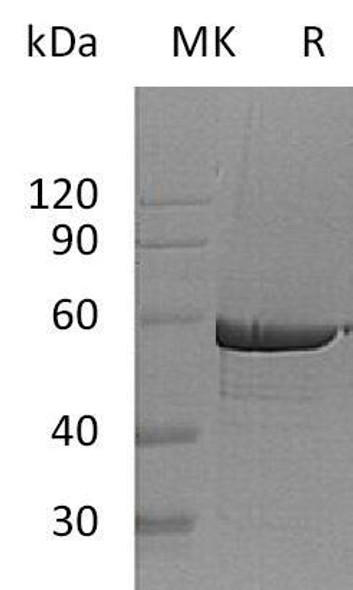Enzymes Recombinant Proteins
Human G6PD Recombinant Protein (RPPB1662)
- SKU:
- RPPB1662
- Product Type:
- Recombinant Protein
- Species:
- Human
- Uniprot:
- P11413
- Research Area:
- Enzymes
Description
| Product Name: | Human G6PD Recombinant Protein |
| Product Code: | RPPB1662 |
| Size: | 20µg |
| Species: | Human |
| Target: | G6PD |
| Synonyms: | G6PD, G6PD1, Glucose-6-phosphate 1-dehydrogenase. |
| Source: | Hi-5 cells |
| Physical Appearance: | Sterile Filtered colorless solution. |
| Formulation: | The G6PD solution (0.5mg/1ml) contains 20mM Tris-HCl buffer (pH 8.0), 0.1mM PMSF, 2mM EDTA, 2mM DTT, 200mM NaCl and 20% glycerol. |
| Stability: | Store at 4°C if entire vial will be used within 2-4 weeks. Store, frozen at -20°C for longer periods of time. For long term storage it is recommended to add a carrier protein (0.1% HSA or BSA).Avoid multiple freeze-thaw cycles. |
| Purity: | Greater than 95% as determined by SDS-PAGE. |
| Amino Acid Sequence: | MGSSHHHHHH SSGLVPRGSH MAEQVALSRT QVCGILREEL FQGDAFHQSD THIFIIMGAS GDLAKKKIYP TIWWLFRDGL LPENTFIVGY ARSRLTVADI RKQSEPFFKA TPEEKLKLED FFARNSYVAG QYDDAASYQR LNSHMNALHL GSQANRLFYL ALPPTVYEAV TKNIHESCMS QIGWNRIIVE KPFGRDLQSS DRLSNHISSL FREDQIYRID HYLGKEMVQN LMVLRFANRI FGPIWNRDNI ACVILTFKEP FGTEGRGGYF DEFGIIRDVM QNHLLQMLCL VAMEKPASTN SDDVRDEKVK VLKCISEVQA NNVVLGQYVG NPDGEGEATK GYLDDPTVPR GSTTATFAAV VLYVENERWD GVPFILRCGK ALNERKAEVR LQFHDVAGDI FHQQCKRNEL VIRVQPNEAV YTKMMTKKPG MFFNPEESEL DLTYGNRYKN VKLPDAYERL ILDVFCGSQM HFVRSDELRE AWRIFTPLLH QIELEKPKPI PYIYGSRGPT EADELMKRVG FQYEGTYKWV NPHKL |
| Biological Activity: | Specific activity is > 45 units/ml obtained by measuring the increase of beta-NADPH in absorbance at 340 nm resulting from the reduction of beta NADP. One unit oxidizes 1.0 umole D-glucose-6-phosphate to 6-phospho-D-gluconate per min in the presence of beta-NADP at pH 7.4 at 25C. |
G6PD is the rate-limiting enzyme of the pentose phosphate pathway, a metabolic pathway that supplies reducing energy to cells by maintaining the level of NADPH. G6PD converts glucose-6-phosphate into 6-phosphogluconolactone and at the same time produces NADPH. The NADPH maintains the level of glutathione in these cells that helps protect the red blood cells against oxidative damage. G6PD deficiency causes acute hemolytic anemia, neonatal jaundice or acute hemolysis. G6PD is a cytosolic enzyme encoded by an X-linked gene whose main function is to produce NADPH, a crucial electron donor in the defense against oxidizing agents and in reductive biosynthetic reactions. G6PD produces pentose sugars for nucleic acid synthesis and is a main producer of NADPH reducing power.
G6PD Human Recombinant produced in Hi-5 cells is a single polypeptide chain containing 535 amino acids (1-515) and having a molecular mass of 61.4kDa.G6PD is fused to a 20 amino acid His-tag at N-terminus & purified by proprietary chromatographic techniques.
| UniProt Protein Function: | G6PD: glucose-6-phosphate dehydrogenase. A cytosolic enzyme encoded by a housekeeping X-linked gene whose main function is to produce NADPH, a key electron donor in the defense against oxidizing agents and in reductive biosynthetic reactions. G6PD is remarkable for its genetic diversity. Many variants of G6PD, mostly produced from missense mutations, have been described with wide ranging levels of enzyme activity and associated clinical symptoms. G6PD deficiency may cause neonatal jaundice, acute hemolysis, or severe chronic non-spherocytic hemolytic anemia. Two splice variant isoforms have been described. The long isoform is found in lymphoblasts, granulocytes and sperm. |
| UniProt Protein Details: | Protein type:EC 1.1.1.49; Carbohydrate Metabolism - pentose phosphate pathway; Cell development/differentiation; Other Amino Acids Metabolism - glutathione; Oxidoreductase Chromosomal Location of Human Ortholog: Xq28 Cellular Component: centrosome; cytoplasm; cytosol; internal side of plasma membrane; intracellular membrane-bound organelle; membrane; microtubule organizing center Molecular Function:glucose binding; glucose-6-phosphate dehydrogenase activity; identical protein binding; NADP binding; protein binding; protein homodimerization activity Biological Process: cholesterol biosynthetic process; erythrocyte maturation; glucose 6-phosphate metabolic process; glutathione metabolic process; lipid metabolic process; NADP metabolic process; NADPH regeneration; pentose biosynthetic process; pentose-phosphate shunt; pentose-phosphate shunt, oxidative branch; ribose phosphate biosynthetic process; substantia nigra development Disease: Anemia, Nonspherocytic Hemolytic, Due To G6pd Deficiency; Favism, Susceptibility To; Malaria, Susceptibility To |
| NCBI Summary: | This gene encodes glucose-6-phosphate dehydrogenase. This protein is a cytosolic enzyme encoded by a housekeeping X-linked gene whose main function is to produce NADPH, a key electron donor in the defense against oxidizing agents and in reductive biosynthetic reactions. G6PD is remarkable for its genetic diversity. Many variants of G6PD, mostly produced from missense mutations, have been described with wide ranging levels of enzyme activity and associated clinical symptoms. G6PD deficiency may cause neonatal jaundice, acute hemolysis, or severe chronic non-spherocytic hemolytic anemia. Two transcript variants encoding different isoforms have been found for this gene. [provided by RefSeq, Jul 2008] |
| UniProt Code: | P11413 |
| NCBI GenInfo Identifier: | 116242483 |
| NCBI Gene ID: | 2539 |
| NCBI Accession: | P11413.4 |
| UniProt Secondary Accession: | P11413,Q16000, Q16765, Q8IU70, Q8IU88, Q8IUA6, Q96PQ2 D3DWX9, |
| UniProt Related Accession: | P11413 |
| Molecular Weight: | 62,468 Da |
| NCBI Full Name: | Glucose-6-phosphate 1-dehydrogenase |
| NCBI Synonym Full Names: | glucose-6-phosphate dehydrogenase |
| NCBI Official Symbol: | G6PD�� |
| NCBI Official Synonym Symbols: | G6PD1�� |
| NCBI Protein Information: | glucose-6-phosphate 1-dehydrogenase |
| UniProt Protein Name: | Glucose-6-phosphate 1-dehydrogenase |
| UniProt Gene Name: | G6PD�� |
| UniProt Entry Name: | G6PD_HUMAN |






